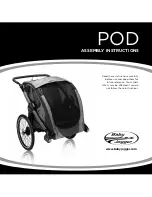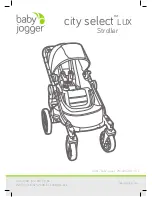
I. Safety Guidelines
Bicycling with a trailer is different from bicycling without one, in ways which aren’t always obvious. Pulling a trailer alters the operation
of the bicycle. Starting, braking and turning are all affected. It is essential that you read and understand the following safety guidelines
prior to using the trailer. Before loaning your trailer to others, make sure they understand its proper and safe use. Contact Nashbar Tech
Support at (800)-888-2710 if any of these instructions are unclear.
Use Well-Maintained Bicycle and Trailer
Be sure that the bicycle used to pull the trailer is in good working order and is equipped with good, properly functioning brakes. Inspect
and maintain your trailer as outlined in this manual. Have a qualified bicycle mechanic maintain and inspect your bicycle and trailer if
you are not qualified to do so.
Loading Your Trailer
Do not overload the trailer. Maximum trailer load limit (combined weight of passengers and cargo) is I00 lbs. When placing children
or cargo in the trailer, keep the load centered over the trailer axle. Pack the load as low as possible and make sure items are secure.
Loose, heavy objects can injure passengers in the event of a sudden stop or tip over.
Starting and Stopping
The additional weight of the trailer requires more time to start and stop. The additional length of the trailer requires more time to cross
intersecting streets or paths. The bicycle and trailer combination is heavier and less responsive than your bicycle alone. You must think
further ahead to anticipate stops and turns. Note that your trailer extends further on the bicycle’s left side; allow for this difference when
turning, passing pedestrians or approaching obstacles (such as posts on bicycle paths). To familiarize yourself with the altered handling
characteristics of your bicycle and trailer, load the trailer to capacity and practice in a safe area. Do not use your trailer until you have
become accustomed to how it affects your bicycle handling.
Prevent Trailer Tip Over
As with automobile and motorcycle trailers, bicycle trailers can tip over. To avoid overturning, avoid potholes and do not pull your trailer
over curbs or other obstructions in the road. Instruct children riding in the trailer not to bounce, rock or lean; such weight shifts may
cause the trailer to lean or flip. Do not turn sharply or at high-speed when pulling the trailer. Always corner with caution at 5 mph or less,
keeping in mind that the trailer cannot lean into a turn the way a bicycle can. Do not under any circumstances exceed 20mph; high
speeds adversely affect your ability to control the bicycle and to notice irregularities in the road surface.
Fit, Alert, Adult Pilot
To safely pull a trailer, you must be a fit, experienced cyclist. You must be alert, and must have good eyesight, hearing and adequate
strength in your legs, arms and hands. Never allow a child or adolescent to pull the trailer because it is likely that they lack the neces-
sary physical ability and judgment.
No Headphones or Other Distractions
Do not bicycle with headphones, radios or other distractions. You must be able to hear surrounding traffic and concentrate on safe bicy-
cling at all times.
No Motorized Vehicles
Your Kid Karriage is intended for use only with pedal-powered bicycles; never pull it with a motorized vehicle, as the increased accel-
eration and speed may damage the trailer or cause the trailer to tip over.
Avoid Riding in Traffic
We recommend against riding in traffic. If you must ride in traffic, do not pull your trailer on highways, busy streets or on streets unsafe
for bicycling with children. Never assume that you will be given the right-of-way, even if it is legally yours. Your child’s safety should not
be entrusted to a car driver whose attention or regard for bicyclists is unknown. Use care when pulling your trailer on bike routes or
along bike lanes, especially at intersections.
2
IV. Disassembly and Storage
Folding your Kid Karriage trailer for storage or transport is basically the reverse of the assembly procedure. You can partially fold the
trailer as necessary. Your options are to fold only the side panels, fold only the hitch arm, remove the wheels or any combination of the
above. Do not operate your trailer in a partially folded condition.
1. Remove the safety flag.
2. Remove the canopy.
3. Remove the wheels. Release the securing clips from the wheel pins, remove the pins from the wheel axles and slide the wheels out
of the trailer frame.
4. Fold the hitch tongue. Remove the hitch pin from the FRONT hole of the hitch tongue bracket, fold the hitch tongue under the trailer body,
and reinsert the hitch pin in the BACK hole of the hitch tongue bracket.
5. Fold the window panels. Release the securing clips from the frame pins, remove the pins from the frame tubes and fold the window
panels into the trailer.
V. Trailer Care and Maintenance
Fabric Care
Your Kid Karriage is manufactured using tough, durable fabrics. The fabric can easily be cleaned using mild soap and warm water. For
more persistent stains, use a soft nylon bristle brush to loosen the stain. Do not use bleach or cleaning solvents to clean the fabric or
any other part of the trailer. Bleach and solvents can weaken or damage the fabric, which is an important safety and structural compo-
nent of the trailer. Replace any fabric that is ripped, scuffed or otherwise damaged.
The fabric used to make the Kid Karriage is designed to be highly resistant to fading, but all fabric will eventually fade, especially when
exposed to direct sunlight. To extend the life of your trailer’s fabric, as well as the hitch and other components, do not store the trailer in
direct sunlight. When not in use, store your trailer in a dry, well ventilated area. After cleaning the fabric or using the trailer in wet condi-
tions, wipe it dry before storing to help prevent mildew.
Don’t forget!
Safety Checklist
Before every ride, check the following:
• Wheels tightly attached
• Tire pressure 35 P.S.I.
• Hitch attached securely and security strap fastened
• Maximum load 100 lbs.
• Bicycle brakes and tires in good condition and operating properly
• Helmets for children and rider
• Safety flag in place
• Both seat buckles securely fastened
Monthly Checklist
• Inspect tongue and hitch for damage, scratches or loose fastener
• Inspect tongue pivot for smooth operation
• Inspect frame tubing and hardware for cracks, damage or loose parts
• Inspect tires for wear or cracks; worn tires should be replaced
• Inspect wheels for trueness and rims for cracks or other damage
• Inspect fabric canopy, child seat and harness for rips, abrasion or missing/ damaged hardware
7
Trailers can tip over, resulting in damage to the trailer and serious injury or death to the cyclist or passengers.
To prevent trailer tipping,
AVOID:
• Children leaning, rocking or bouncing
• Hitting potholes, curbs, or other road obstructions
• Taking turns too fast
• Sudden swerving
• Off-banked turns
• Improper wheel installation
• Improper tire inflation
WARNING
Damaged or ripped fabric components can permit harmful contact between child and spinning wheels or moving pavement, and cause
serious injury. Repair or replace damaged fabric before using trailer.
WARNING






















